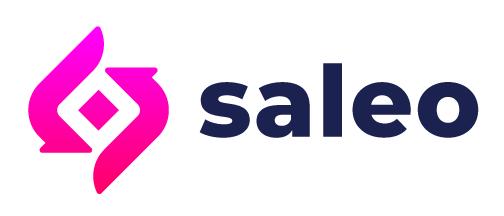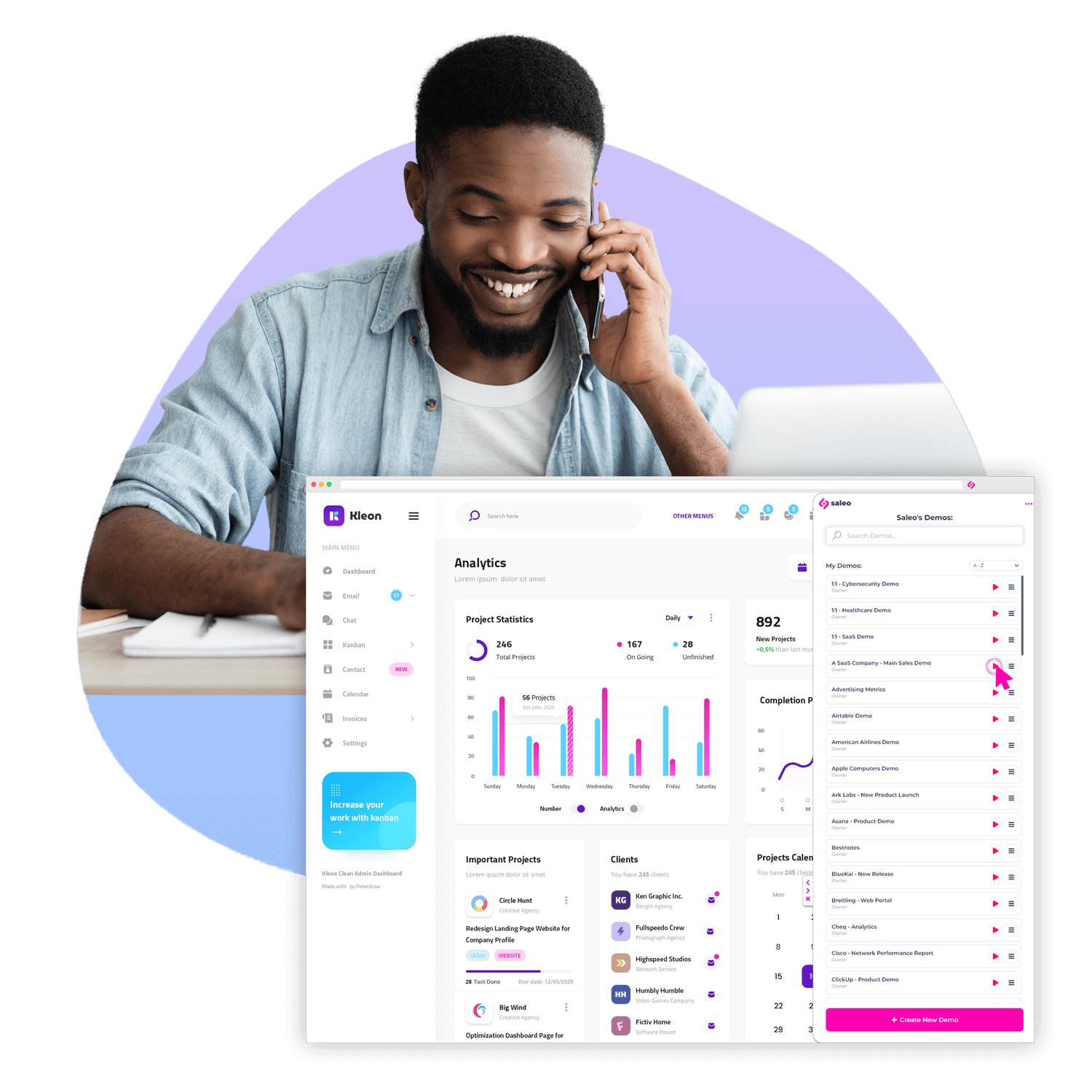Landing the groundwork for a SaaS Product Demo
Gone are the days of one-size-fits-all product demonstrations. Saleo transforms existing sales demo environments for SaaS companies to deliver bespoke and relevant product demonstrations for any buying experience
After your due diligence and requirements gathering is complete you can commence building a custom demo environment for your prospect – a demo that addresses the prospect’s concerns and relevant pain points.
The process in which a demo environment are presented to prospective clients is of the utmost importance; you only get one chance to make a first impression. That means your solution is only as effective as your presentation — so personalizing your demo to your client’s perspective is key.
In order to effectively demo your product that leads to a closed sale, you need the ability to answer client questions by showing them solutions in real time. Generic and non relevant examples and other limitations during your demo can hurt your credibility and negate the power of your product. This ultimately makes your demo environment the most influential tool in your sales pipeline.
How To Prepare the Best Demo Environment
The best demo environments are developed through preparation. The more you can personalize a demo for your prospect, the more impact your demo will have.
- Demo Discovery
- The right people
- Relevant Engagement
- Story with a happy ending
Demo Discovery. Reconnaissance is important. Knowing and throughly understanding your prospects’s problem and pain points will give you the data needed to personalize a relevant sales demo.
It’s also important to make sure all of your equipment is in working order. Being early will ensure that you have time to check the functionality of your setup and, if need be, activate any backup plans should something go wrong.
The right people. Knowing who the decision-makers are in an organization will help to ensure that the right people are there to view your demo.
Relevant Engagement. Having an interactive demo will take your prospect from a passive role to an active one. This will usually lead to higher rates of engagement — more questions asked and answered.
Story with a happy ending. If possible, simulate the exact issue(s) your prospect is having. Acknowledge their issue and show them how your product resolves that issue. A little flair and “Wow factor” always helps!
What Are the Goals of the Pre-Demo?
Pre-demo, also known as sales discovery, is a fact-finding mission. What you discover during your pre-demo will determine what your next steps will be, or even if it makes sense to pursue this prospect at all.
- Identify their pain point(s)
- Determine if your product solves that pain
- Make a plan
Identifying their pain. When performing demo discovery,, identifying what problems motivated your prospect to reach out to you is paramount. Even if they aren’t forthcoming about their pain points, it can usually be determined using context clues. Most pain points fall within four categories: financial, productivity, support or process.
Determining if your product solves that pain. Most salespeople know their product inside and out. It shouldn’t take long to determine if your product is the right fit for this company. If it doesn’t solve the prospect’s pain, simply move on. However, if it does solve the pain, it’s time to…
Make a plan. You’ve started the prospect qualifying process. You’ve determined your product will help alleviate the prospect’s pain. What now?
Now you have an awesomeopportunity to fine-tune your demo by asking additional questions of your prospect. The data you acquire will help you to personalize the demo environment.
Even if your prospect has already been qualified, asking additional questions will only help you to refine your demo environment beforehand. And isn’t that what pre-demo is all about? Refinement?
Let’s take a look at some questions to help qualify your prospect and refine what the final demo environment would need to look like.
- What is the issue that motivated you to seek a solution?
- What are the potential ramifications of this problem not being solved?
- Approximately how much money is this costing your company?
- What are some non-monetary ways that this issue is negatively affecting business?
- Has the company allocated a budget for this project?
- Who has the final say on whether or not the company moves forward with purchasing a subscription?
- May I speak with them or have them sit in on the demo?
- What would you need to see in the demo to move forward?
On top of additional research, this is a great opportunity to lay the groundwork for scheduling and logistics. Lock in a date as soon as possible with all key stakeholders.
What to Avoid in Pre-Demo
There is no reason to go overboard with initial qualifying questions. If your company has overly stringent criteria that few prospective customers could meet, you’re just shooting yourself in the foot. It’s about striking a balance. Casting too wide a net could hurt you, but too narrow a net could as well.
Are there Benefits to a Custom Product Demo?
Of course, there are! Some people are more at home watching a live demonstration, others prefer to jump right in and start clicking buttons. It all comes down to what category your prospect falls into. Ultimately, the more personalization that can be incorporated into the sales demo, the more impact to win rate.
Tips for Presenting Successful Demos
Plan your sales demo before the meeting. You’ve done your due diligence. You’ve customized the demo environment to your prospect and their needs. Why would you start winging it now?
There are many pitfalls waiting for the unprepared during a sales demo. Ask yourself these questions:
- Have I anticipated all of the questions the prospect might have for me?
- Have I prepared clear and concise responses to those questions?
- Do I know the client’s source of pain?
- Does my demo environment adequately show that it solves the client’s pain?
- Have I done a trial run to ensure the sales demo runs smoothly?
- Have I memorized the key points that I’m trying to hit?
Of course, there is almost no such thing as a guaranteed sale, but being prepared will greatly swing the odds in your favor.
What if the Prospect Is Vague about their Pain Point?
Sometimes a client will answer vaguely no matter how pointed and specific your question is. That’s alright. It might take a little more work than you anticipated, but you can get to the bottom of it.
The majority of pain points will end up falling into four categories:
- Finances
- Productivity
- Support
- Processes
Often, one of these problems will have a domino effect, leading to issues in other areas. Example: If the prospect mentions that it takes too long for clients to sign up for their services and that a lot of them give up halfway through, it’s safe to say that that will affect productivity and, in turn, revenue.
Sometimes it’s a very small clue that can lead you to what your prospect’s pain point is.
What Your SaaS Demo Goals Should Be
Obviously, you want to make the sale — that’s a given. What you should concentrate on is knowing every possible thing there is to know about your product. There can’t be any questions that you can’t answer.
If you were unable to show how your product solves the prospect’s pain successfully, there is a good chance that demo should never have happened in the first place.
At the end of the day, if your sales demo showed how it solves the client’s pain, and that you are an expert on your product, you can pat yourself on the back for a job well done.
Increase Your Sales
SaaS sales is a highly competitive world. With a customized demo environment from Saleo, you can expect your prospects to move to the next stage of your sales program with increasing frequency.
To get started with Saleo, request a demo today.





